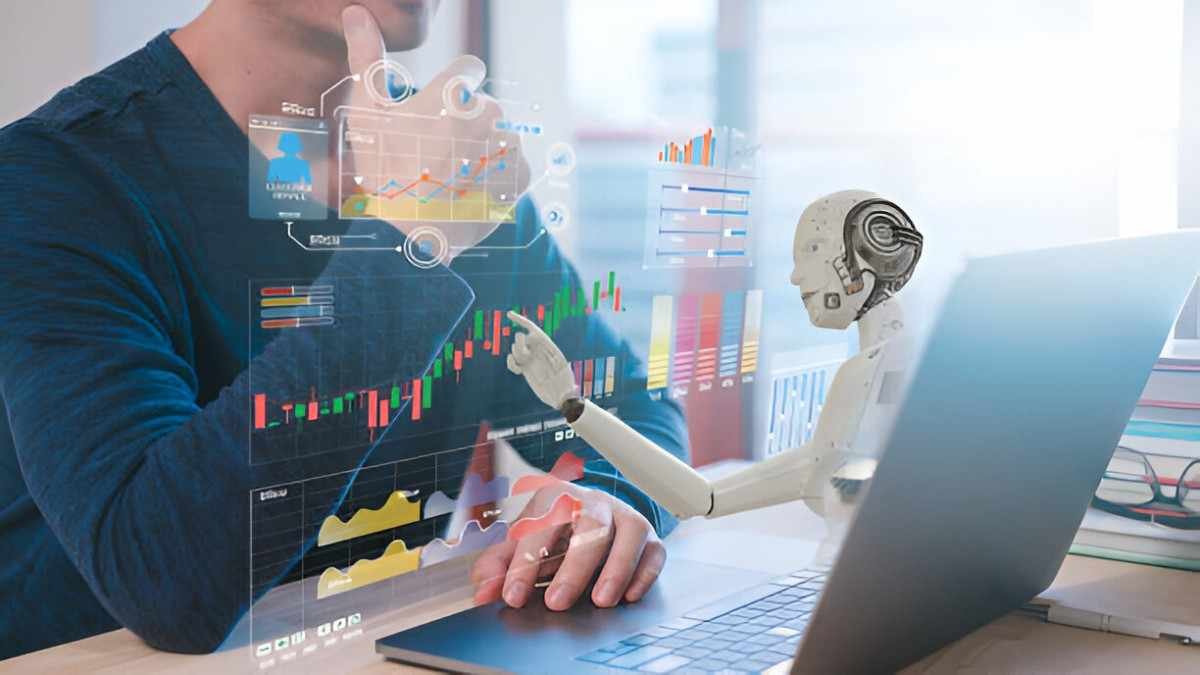When I first heard about automated AI stock trading, I was immediately intrigued by its potential. As someone who has spent years studying the stock market, the idea of combining artificial intelligence with the complex world of stock trading seemed like the natural next step. But like many of you, I had my doubts. Could AI really be trusted to make important financial decisions? Over time, I’ve come to realize that AI-driven trading has transformed the landscape of the financial market, offering a new level of efficiency, speed, and precision that human traders could never match.
Automated AI stock trading uses algorithms to buy and sell stocks based on data analysis. It eliminates the emotional and psychological biases that often impact human decision-making. But like any technology, it’s not without its challenges. In this article, I’ll take you through an in-depth exploration of what automated AI stock trading is, its advantages and drawbacks, and how it’s shaping the future of investment.
Table of Contents
What is Automated AI Stock Trading?
Automated AI stock trading, also known as algorithmic or quantitative trading, involves the use of artificial intelligence (AI) algorithms to execute trades in the stock market. These algorithms analyze vast amounts of data at speeds no human trader could match, making decisions based on predefined rules or patterns. AI stock trading systems can process real-time market data, news, and even social media sentiment to predict stock movements and make trades automatically.
The key to these systems is their ability to learn and adapt over time. Machine learning, a subset of AI, allows the system to continually improve its decision-making based on historical data and new market trends. While traditional stock trading is based on a trader’s analysis and intuition, AI trading systems rely on data-driven insights to make objective and well-informed decisions.
The Benefits of Automated AI Stock Trading
I’ve seen firsthand the advantages of automated AI stock trading. Here are some of the most notable benefits:
1. Speed and Efficiency
One of the biggest advantages of AI trading is its speed. AI systems can process market data in real-time and execute trades almost instantaneously. This is a significant advantage in today’s fast-paced financial markets, where stock prices can change in fractions of a second.
For example, let’s say the stock price of a company is trending upward based on positive news. An AI trading system can identify this trend, execute a buy order, and capture profits before human traders even have a chance to react.
2. Eliminates Emotional Bias
Emotion plays a huge role in human trading decisions. Fear, greed, and overconfidence can lead to poor investment choices. With AI trading, emotions are removed from the equation. The algorithm makes decisions based on data and logic, rather than gut feelings. This leads to more consistent and objective trading strategies.
3. Continuous Market Monitoring
AI systems never sleep. They can monitor market conditions 24/7, scanning for patterns and trends that could present an opportunity or a risk. This round-the-clock monitoring ensures that traders don’t miss valuable opportunities due to time constraints or market hours.
4. Backtesting Capabilities
Backtesting refers to the practice of testing a trading strategy on historical data to see how it would have performed. AI systems excel at backtesting, as they can analyze vast amounts of historical data in a fraction of the time it would take a human to do the same. This helps traders refine their strategies and make more informed decisions.
5. Precision and Accuracy
AI-driven trading systems use complex mathematical models to identify patterns in stock prices. These systems can process much more data than a human could ever handle, allowing for highly accurate predictions. This precision helps traders make more profitable trades while minimizing risks.
The Drawbacks of Automated AI Stock Trading
While AI stock trading offers many advantages, it’s not without its challenges. As much as I admire the technology, I believe it’s important to approach it with caution. Let’s take a look at some of the drawbacks:
1. Over-reliance on Historical Data
AI algorithms are often trained on historical data to predict future stock movements. While this can be effective in many cases, there are times when historical patterns don’t hold. For example, in times of extreme market volatility or unforeseen global events, AI systems may struggle to adapt. In such cases, human intuition and experience can still be invaluable.
2. Lack of Transparency
Some AI trading systems, especially those using machine learning, operate as “black boxes,” meaning that their decision-making processes aren’t always transparent. This lack of transparency can make it difficult for investors to understand how decisions are being made. If a trading algorithm makes a bad decision, it may be challenging to figure out why it happened.
3. Market Impact and Competition
Automated AI trading is becoming more popular, which means that many traders are using similar algorithms. This creates a highly competitive environment, with AI systems constantly competing against each other. In some cases, this can lead to market instability or even flash crashes, where the stock market experiences a sudden and sharp drop due to automated trading activity.
4. Technical Failures
Like any technology, AI trading systems are susceptible to technical failures. A glitch or error in the algorithm could result in disastrous financial consequences. For example, if a system malfunctions and executes trades based on incorrect data, it could cause significant losses.
5. Lack of Human Judgment
AI trading systems rely solely on data and algorithms. While they are great at processing information, they lack the human touch. Certain factors, such as geopolitical events or market sentiment, are difficult to quantify and may not be fully understood by AI systems. Human traders can assess these factors in a way that AI cannot.
How AI Stock Trading Works: A Step-by-Step Guide
If you’re new to the world of AI stock trading, you might be wondering how these systems actually work. Let me break it down for you in simple terms.
Step 1: Data Collection
AI trading systems gather large amounts of data from various sources, including stock prices, news articles, social media, and economic reports. This data is then processed and analyzed by the AI algorithm.
Step 2: Data Analysis
The AI system uses sophisticated algorithms to identify patterns in the data. These patterns are often too complex for humans to detect. The system looks for trends, correlations, and anomalies that could indicate a potential trading opportunity.
Step 3: Decision-Making
Once the AI system has analyzed the data, it makes a decision based on predefined criteria. This could include buying a stock, selling a stock, or holding onto an existing position. The decision-making process is based purely on data, eliminating the emotional biases that can impact human traders.
Step 4: Trade Execution
After making a decision, the AI system automatically executes the trade. This is done at lightning speed, ensuring that the trade is executed at the best possible price.
Step 5: Monitoring and Adjustment
Once the trade is executed, the AI system continues to monitor the market for any changes. If the market conditions change, the system may adjust its strategy accordingly. This continuous monitoring and adjustment help the system stay ahead of market trends.
The Role of Machine Learning in AI Stock Trading
Machine learning is a critical component of AI stock trading. Unlike traditional algorithms that follow fixed rules, machine learning algorithms are designed to learn from data and improve over time. Here’s how it works:
Supervised Learning
In supervised learning, the AI system is trained on a labeled dataset, where the correct answers (buy, sell, hold) are provided. The system learns from this data and applies the patterns it identifies to new, unseen data. This allows the AI to make predictions based on past trends.
Unsupervised Learning
Unsupervised learning involves training the AI system on unlabeled data. The system must identify patterns and relationships in the data on its own, without guidance. This type of learning is useful for identifying hidden trends in the market that may not be immediately apparent.
Reinforcement Learning
Reinforcement learning is a type of machine learning where the AI system learns by trial and error. The system is rewarded for making profitable decisions and penalized for making losses. Over time, the system learns to optimize its trading strategy by maximizing rewards and minimizing penalties.
AI Trading vs. Traditional Trading: A Comparison
I think it’s important to compare AI trading with traditional stock trading to fully understand its advantages and limitations. Below is a simple table illustrating the differences:
| Feature | AI Stock Trading | Traditional Stock Trading |
|---|---|---|
| Speed | Fast, real-time decision-making | Slower, dependent on human reaction time |
| Emotions | No emotional biases | Decisions can be influenced by emotions |
| 24/7 Monitoring | Always on, can monitor markets 24/7 | Limited to market hours |
| Complexity Handling | Can handle complex data and patterns | Limited to simpler analysis |
| Risk Management | Algorithms can adjust based on predefined rules | Relies on human judgment and experience |
| Transparency | Can be opaque, especially with machine learning | Fully transparent decisions |
Real-Life Examples of AI Stock Trading Systems
Let’s take a look at some real-life examples of AI-driven trading systems:
1. Robo-Advisors
Robo-advisors are automated investment platforms that use algorithms to create and manage an investment portfolio. They analyze a person’s financial situation, goals, and risk tolerance to recommend a diversified portfolio. Some popular robo-advisors include Betterment and Wealthfront.
2. High-Frequency Trading (HFT)
High-frequency trading is a form of AI trading that uses powerful computers to execute a large number of trades at extremely high speeds. HFT firms use complex algorithms to take advantage of tiny price movements in the market. While HFT can be highly profitable, it has been criticized for contributing to market volatility.
3. Quantitative Hedge Funds
Quantitative hedge funds, like Renaissance Technologies and Two Sigma, rely on AI algorithms to make trading decisions. These funds use machine learning to analyze vast amounts of data and identify profitable opportunities. They are some of the most successful and secretive firms in the investment world.
Conclusion: Is AI Stock Trading the Future?
In my opinion, automated AI stock trading is here to stay. It offers numerous advantages, including speed, efficiency, and the ability to process vast amounts of data. While there are challenges, such as over-reliance on historical data and technical failures, AI trading is undoubtedly transforming the world of investing. As the technology continues to evolve, I believe it will only become more sophisticated and accessible to individual investors.
For those willing to embrace the future of investing, AI-driven trading offers an exciting opportunity to stay ahead of the curve. However, like any investment strategy, it’s essential to approach it with caution and a deep understanding of the underlying technology. After all, in the world of trading, knowledge is just as important as the tools you use.





